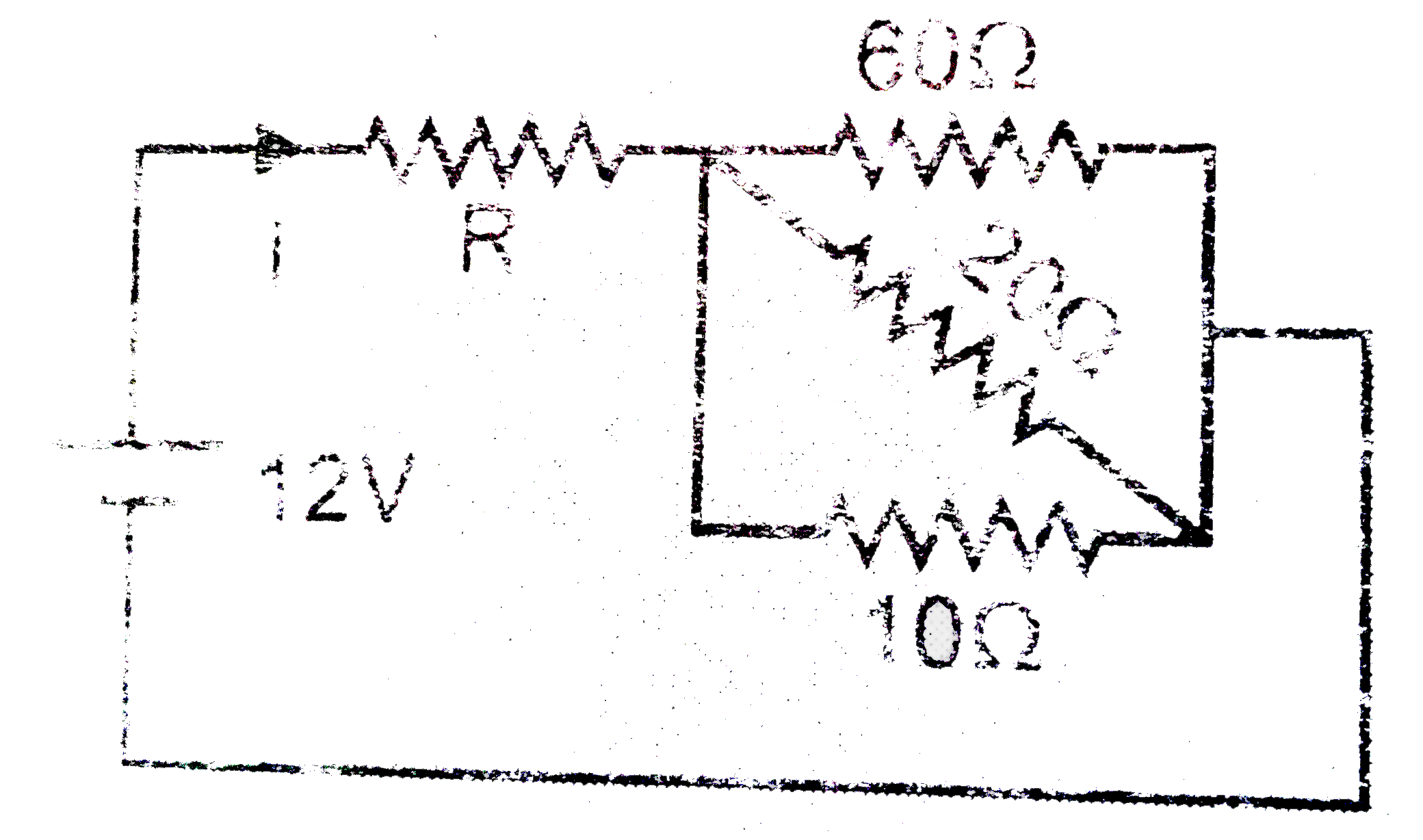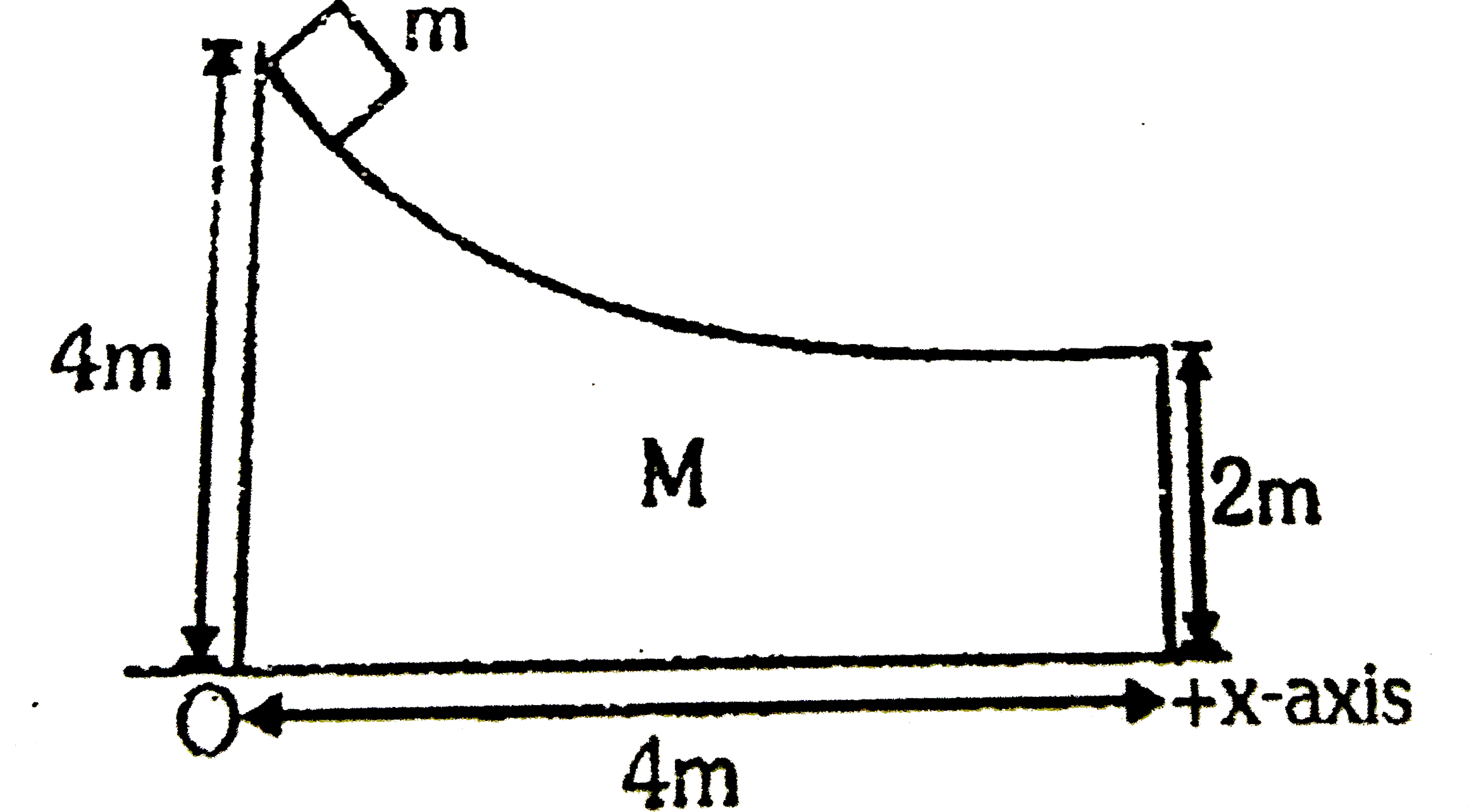Comprehension # 1
If net force on a system in a particular direction is zero (say in horizontal direction) we can apply:
ΣmRxR=ΣmLxL,ΣmRvR=ΣmLvL and ΣmRaR=ΣmLaL
Here R stands for the masses which are moving towards right and L for the masses towards left, x is displacement, v is veloctiy and a the acceleration (all with respect to ground). A small block of mass m=1kg is placed over a wedge of mass M=4kg as shown in figure. Mass m is released from rest. All surface are smooth. Origin O is as shown. The block will strike the x-axis at x= ............ m :-Solution in Gujrati
4.2
7.6
5.6
6.8
The correct Answer is:D
When 'm' leavers the wedge 'M' then wedge moves distance 'x' in left side
∴M(4−x)=Mx⇒=0.8m
∴ Co-ordinate where block will be leave wedge
x=4−0.8=3.2
Time for m will strike the ground is =√2×210
∴xf=3.2+4√2×2√10=6.8m
Topper's Solved these Questions
- CENTRE OF MASSBOOK - ALLEN CHAPTER - CENTRE OF MASSEXERCISE - EXERCISE-IV A
32 Videos
- CENTRE OF MASSBOOK - ALLEN CHAPTER - CENTRE OF MASSEXERCISE - EXERCISE-IV B
14 Videos
- CENTRE OF MASSBOOK - ALLEN CHAPTER - CENTRE OF MASSEXERCISE - EXERCISE-II
43 Videos
- BASIC MATHEMATICS USED IN PHYSICS &VECTORS BOOK - ALLEN CHAPTER - BASIC MATHEMATICS USED IN PHYSICS &VECTORS EXERCISE - EXERCISE-IV ASSERTION & REASON
11 Videos
- ELASTICITY, SURFACE TENSION AND FLUID MECHANICSBOOK - ALLEN CHAPTER - ELASTICITY, SURFACE TENSION AND FLUID MECHANICSEXERCISE - Exercise 5 B (Integer Type Questions)
3 Videos
Similar Questions
Fig. shown a uniform square plate from identical squares at the corners can be removed. (a) Where is the centre of mass of the plate originally ? (b) Where is it after square 1 is removed ?
(c ) where is it after squares 1 and 2 are removed ? (d) Where is c.m after squares 1,2,3, are removed ?
(f) Where is c.m after all the four squares are removed ? Answer in terms of quadrants and axes.

View SolutionA bullet of mass M is fired with a velocity 50m/s at an angle with the horizontal. At the highest point of its trajectory, it collides head-on with a bob of mass 3M suspended by a massless string of length 10/3 metres and gets embeded in the bob. After the collision, the string moves through an angle of 120∘. Find
(i) the angle θ,
(ii) the vertical and horizontal coordinates of the initial position of the bob with respect to the point of firing of the bullet. Take g=10m/s2
View SolutionTwo particle A and B start moving due to their mutual interaction only. If at any tiem 't', →aA and →aB are their respective accelerations, →vA and →vB are their respective velocities, and upto that time WA and WB are the work done on A and B respectively by the mutual force, mA and mB are their masses respectively, then which of the following is alwys correct.
View SolutionAssertion: If the initial and final positions coincide, the displacement is a null vector.
Reason: A physical quantity can not be called a vector, if its magnitude is zero.
View SolutionTwo soap bubbles A and B are kept in a closed chamber where the air is maintained at pressure 8N/m2.The radii of bubbles A and B are 2cm and 4cm, respectively. Surface tension of the soap-water used to make bubbles is 0.04N/m. Find tha ratio nB/nA, where nA and nB are the number of moles of air in bubbles A and B, respectively. [Neglect the effect of gravity.]
View SolutionComprehension # 1 If net force on a system in a particular direction is zero (say in horizontal direction) we can apply: Sigmam_(R )x_(R )= Sigmam_(L)x_(L), Sigmam_(R )v_(R )= Sigmam_(L)v_(L) and Sigmam_(R )a_(R ) = Sigmam_(L)a_(L) Here R stands for the masses which are moving towards right and L for the masses towards left, x is displacement, v is veloctiy and a the acceleration (all with respect to ground). A small block of mass m = 1 kg is placed over a wedge of mass M = 4 kg as shown in figure. Mass m is released from rest. All surface are smooth. Origin O is as shown. Final velocity of the wedge is .......... m//s :-
View SolutionComprehension # 1 If net force on a system in a particular direction is zero (say in horizontal direction) we can apply: Sigmam_(R )x_(R )= Sigmam_(L)x_(L), Sigmam_(R )v_(R )= Sigmam_(L)v_(L) and Sigmam_(R )a_(R ) = Sigmam_(L)a_(L) Here R stands for the masses which are moving towards right and L for the masses towards left, x is displacement, v is veloctiy and a the acceleration (all with respect to ground). A small block of mass m = 1 kg is placed over a wedge of mass M = 4 kg as shown in figure. Mass m is released from rest. All surface are smooth. Origin O is as shown. The block will strike the x-axis at x = ............ m :-
View SolutionComprehension # 1
If net force on a system in a particular direction is zero (say in horizontal direction) we can apply:
ΣmRxR=ΣmLxL,ΣmRvR=ΣmLvL and ΣmRaR=ΣmLaL
Here R stands for the masses which are moving towards right and L for the masses towards left, x is displacement, v is veloctiy and a the acceleration (all with respect to ground). A small block of mass m=1kg is placed over a wedge of mass M=4kg as shown in figure. Mass m is released from rest. All surface are smooth. Origin O is as shown.

Normal reaction between the two blocks at an instant when absolute acceleration of m is 5√3m/s2 at 60∘ with horizontal is ......... N. Normal reaction at this instant is making 30∘ with horizontal :-
View SolutionComprehension # 1
If net force on a system in a particular direction is zero (say in horizontal direction) we can apply:
ΣmRxR=ΣmLxL,ΣmRvR=ΣmLvL and ΣmRaR=ΣmLaL
Here R stands for the masses which are moving towards right and L for the masses towards left, x is displacement, v is veloctiy and a the acceleration (all with respect to ground). A small block of mass m=1kg is placed over a wedge of mass M=4kg as shown in figure. Mass m is released from rest. All surface are smooth. Origin O is as shown.

At the same instant reaction on the wedge from the ground is ........N.
View SolutionStatement-1: If the centre of mass of a system is at the origin then the total mass to the right of origin is same as total mass to left of origin. Statement-2: x_(cm)=(Sigmam_(i)x_(i))/(Sigmam_(i))
View SolutionIn an AC, series L-C-R circuit, R=XL=XC and applied AC, voltage is V. Then match the following two columns.

View SolutionIn an L-C-R circuit, if V is the effective value of the applied voltage V_(R) is the voltage across R, V_(L) is the effective voltage across L, V_(C) is the effective voltage across C, then
View SolutionIn a cone, (l+r)(l-r) = ………
View SolutionIn a series LCR circuit, VL=VC≠VR. What is the value of power factor ?
View Solution(A): At resonance power factor of L-C-R series circuit is unity.
(R) : At resonance XC=XL
View SolutionComprehension # 1 If net force on a system in a particular direction is zero (say in horizontal direction), we can apply: Sigmam_(R )x_(R )= Sigmam_(L)x_(L) , Sigmam_(R )v_(R )= Sigmam_(L)v_(L) and Sigmam_(R )a_(R ) = Sigmam_(L)a_(L) Here R stands for the masses which are moving towards right and L for the masses towards left, x is displacement, v is velocity and a the acceleration (all with respect to ground). A small block of mass m = 1 kg is placed over a wedge of mass M = 4 kg as shown in figure. Mass m is released from rest. All surface are smooth. Origin O is as shown. Final velocity of the wedge is .......... m//s :-
View Solution
